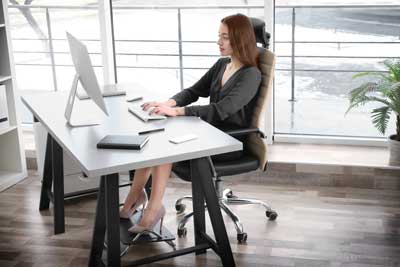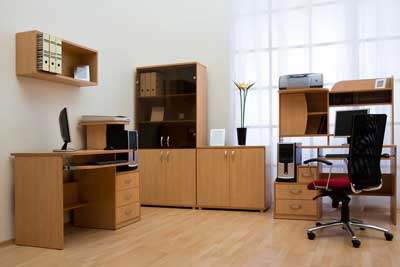Quality office furniture is not only an essential component of your business’s workspace but also key to employee productivity. Unfortunately, many businesses tasked with buying office furniture fail to consider many things that contribute to their organization’s success.
Here are 12 common office furniture mistakes you can avoid with a little forethought.
1. Skimping on Ergonomic Office Furniture
Given that employees spend 40+ hours a week at work, it’s important to choose office furniture that promotes health and comfort. According to OSHA, ergonomics help reduce muscle fatigue, protect against musculoskeletal disorders like carpal tunnel syndrome, and encourage higher productivity. You just can’t go wrong with ergonomic office furniture.
2. Not Thinking About Privacy
Many employees have trouble working as productively in an open environment. Distracting noise levels, increased interruptions, and a lack of privacy are all significant problems that can be reduced with different furniture choices.
For those companies that still hope to achieve the smooth aesthetics of an open office, you may want to consider short-to-moderate-sized partitions between workspaces and sound-mitigating materials. Customizable-height panels like the Prefix System are a great way to maintain the level of privacy you need.
3. Choosing the Wrong Office Chair Legs
 When shopping for office chairs, it’s easy to forget about chair legs. But many employees benefit from rolling legs, which allow them to move around their workstation to more easily access documents and tools.
When shopping for office chairs, it’s easy to forget about chair legs. But many employees benefit from rolling legs, which allow them to move around their workstation to more easily access documents and tools.
You may not need rolling chair legs in waiting areas and conference rooms. However, most employees will greatly appreciate the feature at their desks.
4. Not Allocating Sufficient Funds
Many business owners are surprised to find that they can’t supply their entire office with new furniture for just a couple hundred bucks. Even if you’re willing to purchase low-end or well-used furniture, you’re unlikely to be able to afford more than a few pieces at that price.
If you’re looking to buy higher-end office furniture, you may need to spend as much as a few thousand dollars per employee. Keep in mind that office furniture is an investment in your company’s future. In the long run, your investment will pay off in terms of productivity and employee satisfaction.
5. Choosing Poor Upholstery
Furniture fabric has an often-overlooked effect on the overall comfort and lifespan of your furniture. If you choose good upholstery, your office furniture will last much longer, keep your employees comfortable, and retain its value over time. Companies that prize comfort, luxury, or making a good impression on visitors often choose leather office chairs for that special sense of style.
If you’re looking to spend less, you may want to consider vinyl or polyester. These durable, long-lasting, and moisture-resistant materials are easier on your budget.
6. Choosing Colors That Don’t Match
 It’s easy to think color doesn’t matter, especially for something as functional as office furniture. However, the color scheme in your office will affect how you come across to any visitors or clients who stop by. Outdated or eclectic colors will make your company seem out-of-date.
It’s easy to think color doesn’t matter, especially for something as functional as office furniture. However, the color scheme in your office will affect how you come across to any visitors or clients who stop by. Outdated or eclectic colors will make your company seem out-of-date.
Don’t assume that any neutral shade will fit with the rest of your office. Many designers think black and brown furniture clash with each other. Instead, consider a simple-but-modern color scheme like all black, silver and black, blue and gray, or white and brown. If you’re not sure what colors will work best together, consider asking an expert or looking to furniture design magazines for inspiration.
7. Failing to Consider the Future
Most companies don’t keep the same number of employees at all times. If you own a small business that is predicted to grow, you will likely need more space in a few years — and more furniture.
To ensure your office retains a smooth, consistent appearance, it’s often best to buy additional pieces of furniture in the beginning so it will be there when you add new team members. For companies with 15-30 employees, we recommend purchasing at least 5 extra workstations to accommodate any new employees you hire in the near future.
8. Choosing Office Desks Without Slide-Out Trays
Statistics show that 3 to 6 percent of the population is affected by carpal tunnel syndrome (CTS), a common condition that causes pain and tingling in the hand or arm. The percentage is even higher among office workers who type on a computer keyboard for multiple hours a day.
You can help protect your employees from CTS by investing in computer desks with slide-out trays. This allows the keyboard to sit below the desk surface so users experience less wrist stress while typing. Ideally, trays should be at least 22 to 28 inches from the floor.
9. Buying Furniture That Doesn’t Fit in Your Office
Many businesses fail to measure their space or consider what size furniture fits in that space before purchasing office desks and chairs. In general, you should try to include 4-5’ of space between the wall and any tables or desks.
For a 15’ x 13’ conference room, we recommend choosing a roughly 60” x 40” table to comfortably accommodate 4-6 people. A 34’ x 14’ room mat requires a 288” x 58” table to seat two dozen people.
10. Not Buying Furniture With a Warranty
Be wary of seemingly good deals on office furniture that don’t include a warranty. If neither the manufacturer nor the vendor offers a warranty, it may be because the furniture is likely to break. Then you’ll have to pay for repairs and replacements yourself.
Most reputable office furniture manufacturers guarantee their products will have no defects for at least a year. If you choose furniture with this sort of warranty, you may actually be saving money in the long run.
11. Buying One-Size-Fits-All
As you probably realize, not every employee is the same size and shape. Unfortunately, standard office furniture does not always take this into consideration. Most non-adjustable office furniture is designed for a 5’9” worker with average proportions, leaving employees who don’t fit that narrow mold at a higher risk of workplace injury and discomfort.
As a minimum, we recommend choosing office chairs and desks with an adjustable height. This ensures employees can keep their feet on the floor and wrists at a comfortable height.
12. Thinking Only About Your Current Arrangement
Many offices rearrange their furniture sooner or later. If your company chooses to do this, you may benefit from modular or reconfigurable office furniture like the Emerge Frame & Tile system. Interchangeable tiles, flexible steel frames, and other innovations can help make changing up your office configuration a breeze.
Everett Office Furniture supplies high-quality new and used office furniture to companies, hospitals, and education settings throughout Snohomish County. Explore our furniture collection or contact us today to find out more about improving your workspace.